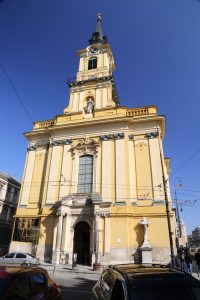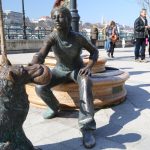 John M. Edwards tours the ambivalent history of terror in the Hungarian capital
John M. Edwards tours the ambivalent history of terror in the Hungarian capital
Outside the museum on infamous Andrassy utca stood a young Hungarian law student wearing an anachronistic frockcoat straight out of some 19th-century novel. He said his name was Andros and asked me for a cigarette. He then lit it and smiled pleasantly.
“Did you know that there was a persistent rumor during World War II that our ghoulash bowls were full of human flesh from the torture victims killed here?” he said with a superior sneer.
Hold on, that’s a lie!
There is no Andros and I made up the quote. Or, just maybe, maybe, I’m protecting the identity of one of my sources.
Yet there was indeed something stomach-churning about entering Budapest’s “House of Terror”—the former headquarters of the secret polices of both the Nazis and the Communists. Once inside I stumbled into a larger-than-life videoscreen of none other than Adolf Hitler himself, barking like a rabid Doberman at an impressive pep rally. Surely the scariest dude who ever lived, I’ll give him one thing: he spoke with conviction. And he successfully retired permanently the then-popular black square mustache, also worn by the likes of Hardy and “The Little Tramp,” from the fickle world of fashion and style. As my high-school history prof Max Munzel would put it, “Hitler was a madman, but he was a genius!”
Pumped in through loudspeakers was a whooshing whirligig of white noise containing screams, howls, and shrieks—lifted, I’m sure, from the soundtrack of Quentin Tarantino’s and Eli Roth’s horrific shocker “Hostel.”
The House of Terror showcases the extreme madness that held Hungary hostage for over 50 years. A series of high-tech avant-garde videoscreens flash the REM nightmare past with unforgiving and unflinching candor.
Getting a gander at the Hungarian equivalent of the Nazis, the Arrow Cross, with their space-age insignias (not swastikas) and Buck Rogers uniforms, I imagined they looked sort of out of this world. They purportedly tortured and killed hundreds of Jewish prisoners in the basement of the building—and delighted in tying victims together and chucking them into the classical freezing bile of the Blue Danube.
The material the curious caretakers have on the Communists is even worse. The displays of the Soviet secret police, the AVO (later renamed the AVH) succeed in demonizing the disasters of deportations, imprisonments, and executions—many of them covert. The labyrinthine corridors eventually lead to the “Hall of Tears,” remembering 25,000 freedom fighters who were killed during the failed 1956 Hungarian Uprising against the Soviets.
But all agonizing brooding ceases with a catharsis: celebratory scenes of the overthrow of the Communist government in 1991, the symbolic reburial of local hero Imre Nagy, and even a nice visit by the Pope.
But what I liked most about the museum was that there were absolutely no docents.
The lack of commentary makes the effect all the more powerful. But not according to Hungary’s small remaining Jewish community, who generally believe that the museum minimizes the Holocaust.
What’s more, some critics claim the museum could actually re-inspire the very extremism and right-wing hatreds they are in fact condemning by in some weird way memorializing them.
“Many of the Communist traitors were Jews!” Andros, my fictional law student, bruits, with a wicked gleam in his eye. Then he walks off abruptly, without saying goodbye, and vanishes like a vampyr down the long dark street into the distance–with, of course, his subversive frockcoat flapping in the wind like a pretty good ending. . . .





Leave a Reply